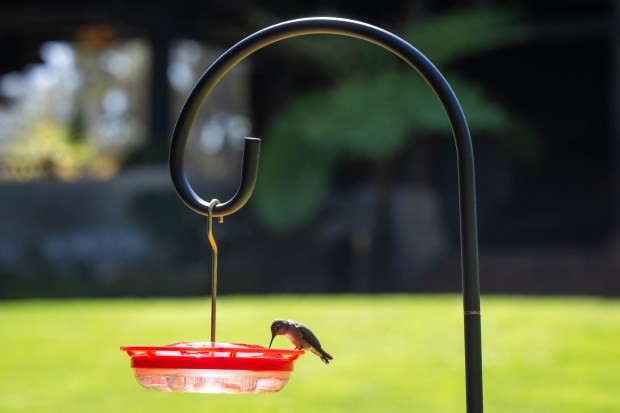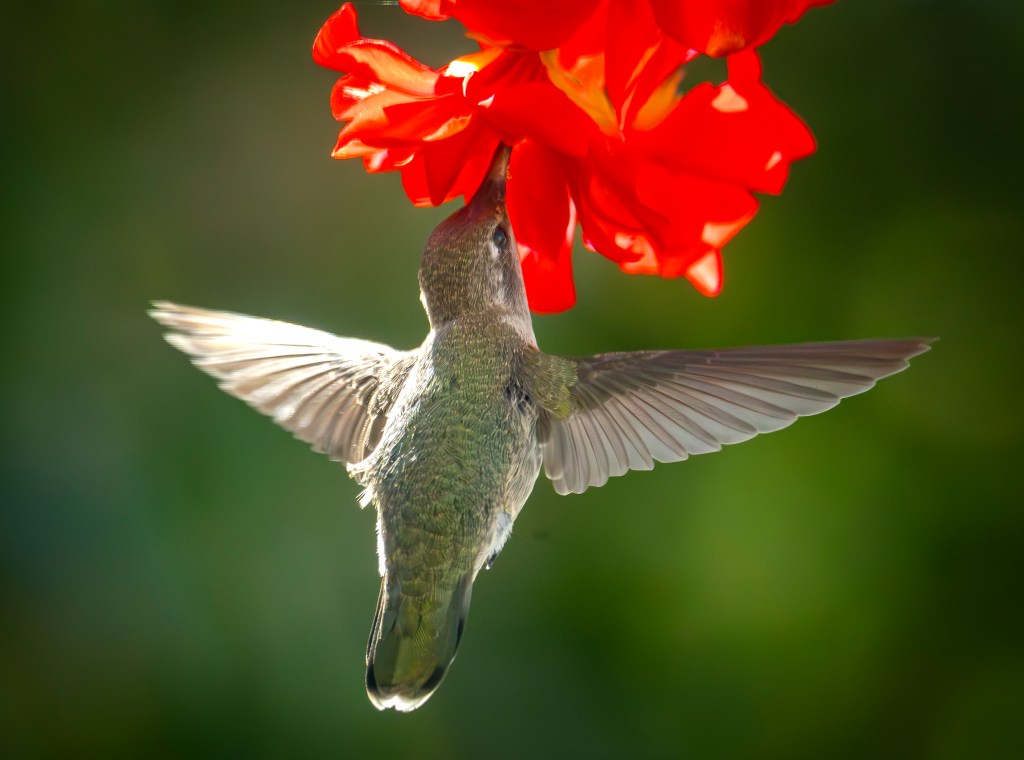Fun Fact #1: There are over 300 species of hummingbirds, according to the U.S. Fish & Wildlife Service. They are all citizens of the Americas…North, Central, and South. They can be encountered as far north as Alaska and as far south as Chile.
Their family name is Trochilidae…not really much of a fun fact.
For many U.S. hummingbird species, their winter travel plans include Mexico, Costa Rica, Ecuador and Peru. The rest go to Applebee’s…for their unlimited wonton tacos.

Clarence Schmidt
Clarence Schmidt
For me, these “flying jewels” are fascinating to watch for their beauty, iridescent feathers, tiny size and impressive speed and endurance.
Fun Fact #2: I’m not sure how ornithologists determine this, but according to Fish & Wildlife Service, ruby-throated hummingbirds can fly the 500-mile journey across the Gulf of Mexico (or it the Gulf of America?) in less than a day.
Hopefully, they had a full tank of nectar because there are no rest stops to land and refuel. That’s pretty good miles to the gallon for those little wing flappers.
Hey, I wonder how far my truck could go on a gallon of nectar.
According to AllAboutBirds.org, they risk flying thousands of miles between breeding grounds and winter habitats every year. “Rufous hummingbirds travel nearly 4,000 miles from breeding grounds in Alaska and northwest Canada to wintering sites in Mexico,” the website says.
Fun Fact #3: According to the Sierra Club, California is a winter destination for migratory hummingbirds, including the Anna’s hummingbird, a year-round, nesting resident at Point Loma’s Cabrillo National Monument. “In April, birders flock to the National Monument to observe the Calliope hummingbird, the smallest bird in the United States,” the Sierra Club said.
Our yard has been their favorite sanctuary for decades. I have a buffet of natural nectar sources. My feeders are always well-stocked when they’re in town. They eat very well and it’s a wonder they can even get airborne.
Our orchard provides them with food, shady perches, lookout towers and protective shelter.
They have no real predators. The water buffalos are nearly extinct in our yard, although foxes, coyotes, bobcats, possums, squirrels, gophers, rabbits, hawks, owls, and an occasional camel, roam freely.
The birdbath is heated with fresh clean hotel towels provided daily. Every hour is Happy Hour. Massages are available upon request. Our place is a resort for them.
They don’t need to travel long distances to breed. They can do it right here. I won’t watch.
Questionable Fact #1: I’m not going to get into their reproductive system, but you can do so at…https://www.hummingbirdspot.com/anatomy
They’re intelligent, much more so than the woodpeckers who just hammer trees with their heads all day.
They have impressive memories and can remember every yard they visited, every feeder they drank from, and the names of our grandkids.
 A hummingbird visits ta feeder. Sarah Reingewirtz, Los Angeles Daily News/SCNG)
A hummingbird visits ta feeder. Sarah Reingewirtz, Los Angeles Daily News/SCNG)
Hummingbirds choose their favorite locations based on geography, as well as a combination of natural nectar sources, their favorite flowers, well-placed feeders and how much they like the homeowner.
I’ve noticed that fewer birds visited after I changed the nectar that I had long used. They demonstrated and carried protest signs. Their penmanship was excellent. The feeder contained no dye, but I think some of the stuff fermented.
Terrible Fact (??) #1: How many hummingbirds does it take to change a lightbulb? Toucan do it.
Fun Fact #4: The Audubon Society says, “to sustain their supercharged metabolisms, hummingbirds must eat once every 10 to 15 minutes and visit between 1,000 and 2,000 flowers per day.” They use their long bills and tube-like tongues to drink nectar from flowers to fuel their high metabolism.
So, exactly, how do they make it across the Gulf of Mexico?
These guys have a sweet tooth and go straight for the glucose. Supposedly, they can eat more than twice their body weight daily. (Trust but verify.)
Sad Fact: “As of 2024, twenty-one hummingbird species are listed as endangered or critically endangered, with numerous species declining in population.” (Source: International Union for Conservation of Nature’s Red List of Threatened Species).
According to UC Davis, “over 160 native North American plants rely on hummingbirds to pollinate them exclusively.”
Last Fun Fact: According to OleMiss.edu, “Those little winged wonders flutter their wings at a remarkable 80 times per second! They do NOT flap their wings; they rotate them in a figure 8…”
Big Fat Lie #1: Someone with extremely rapid eye movement counted those times.
They hover over their food instead of landing. Their wings can propel them forward, backwar, and upside down. The Olympic qualifiers can do cartwheels, back flips, and pirouettes.
We’ve had some traffic jams at our feeders, but the natural nectar from flowers is healthier for them so they’ll always prioritize a yummy flower over a feeder.
I had to hang another feeder out of sight to prevent a bully from terrorizing the others. They will buzz me if I get too close to their feeder. They will aggressively defend their territory and protect their young.
Regarding pest control, they can eat on the fly and snatch insects. A Michelin star-worthy meal consists of aphids, gnats, mosquitos, whiteflies and other small insects from leaves and spider webs.
For those of you who are expecting me to make a joke about hummingbirds humming because they don’t know the words…well just forget it.
If you want to attract hummers to your yard, provide some safe, protected places for them to rest, sleep and survey their territory.
Consider planting some of their favorites: beebalm, columbine, fuchsia, larkspur, penstemon, sage and trumpet honeysuckle.
Hanging a basket with overripe fruit or banana peels will attract tiny fruit flies for them to supplement their diet.
A group of hummingbirds is called a charm. Now that’s a fun fact.
Schmidt is a Poway resident with over 40 years of gardening experience.

